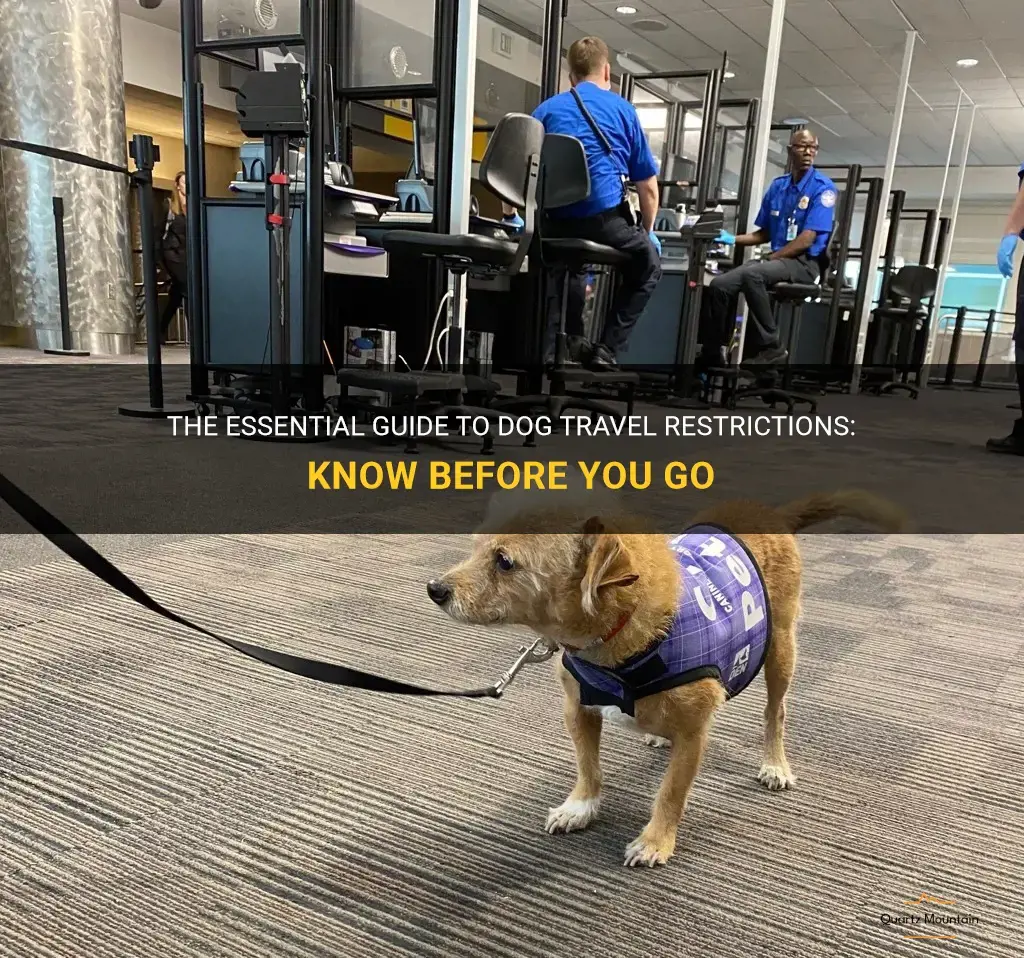
From airplanes to buses, hotels to rental homes, it seems like dogs are always facing some sort of travel restriction. While we may think of our furry friends as part of the family, the reality is that there are many reasons why travel restrictions for dogs exist. Whether it's to maintain cleanliness, prevent allergies, or ensure the safety of other passengers, these restrictions play an important role in the travel industry. In this article, we will explore some common dog travel restrictions and the reasons behind them, as well as provide tips for navigating these limitations when traveling with your beloved pup. So grab your leash and let's embark on a journey through the world of dog travel restrictions!
What You'll Learn
- What are the current travel restrictions for dogs when flying internationally?
- Are there any specific breeds of dogs that face more travel restrictions than others?
- How do I find out about travel restrictions for dogs when traveling within my own country?
- Are there any health requirements that dogs must meet before traveling internationally?
- Are there any countries that have stricter travel restrictions for dogs compared to others?

What are the current travel restrictions for dogs when flying internationally?

As international travel becomes more accessible and popular, many pet owners are wondering what the current travel restrictions are for dogs when flying internationally. It is important to note that each country has its own regulations and requirements for importing pets, including dogs. These regulations are in place to ensure the safety and well-being of both the animals and the human population.
One of the most common requirements for dogs traveling internationally is a valid health certificate issued by a veterinarian. This certificate usually needs to be issued within a specified time frame, often 10 days to a month before travel. The health certificate typically confirms that the dog is in good health, free from any infectious diseases, and has been properly vaccinated. It is important to consult with a veterinarian to ensure that all necessary vaccinations are up to date and to obtain the required health certificate.
Another common requirement for dogs traveling internationally is the microchipping. Many countries require dogs to be microchipped, which involves inserting a small identification chip under the skin. This chip contains the dog's unique identification number, which can be scanned to retrieve the owner's contact information. Microchipping helps to ensure that dogs can be properly identified and reunited with their owners if they become lost during travel.
In addition to health certificates and microchipping, some countries may have specific entry requirements for dogs depending on the region they are traveling from. For example, certain countries may require dogs from specific regions to undergo additional tests or treatments for diseases such as rabies. It is important to research and comply with the specific entry requirements of the destination country to avoid any complications or delays during travel.
It is also worth noting that airlines may have their own regulations and restrictions for traveling with dogs. Many airlines have specific guidelines for the size and weight of dogs that can be transported, as well as requirements for the type of carrier or crate that should be used. It is important to check with the airline when booking a flight to ensure that all necessary requirements are met.
Overall, when it comes to traveling internationally with a dog, it is crucial to do thorough research and preparation in advance. This includes ensuring that all required vaccinations are up to date, obtaining the necessary health certificate, microchipping the dog, and complying with any specific entry requirements of the destination country. By following these regulations and requirements, pet owners can ensure a safe and smooth travel experience for themselves and their furry companions.

Are there any specific breeds of dogs that face more travel restrictions than others?

When it comes to traveling with pets, there are certain breeds of dogs that may face more travel restrictions than others. This could be due to various factors such as breed-specific regulations, health concerns, or general safety concerns. Let's explore some of the specific breeds that may face more travel restrictions.
- Pit Bulls and Staffordshire Terriers: Pit Bulls and Staffordshire Terriers are two breeds that often face travel restrictions due to breed-specific legislation (BSL) implemented in certain areas. BSL refers to laws or regulations that target specific breeds deemed to be dangerous. These restrictions can restrict travel or require additional documentation or precautions when traveling with these breeds.
- Rottweilers: Similar to Pit Bulls and Staffordshire Terriers, Rottweilers may face travel restrictions in certain areas due to BSL or other breed-specific regulations. Owners should research and understand the restrictions in their travel destination before planning a trip with their Rottweiler.
- German Shepherds: German Shepherds are another breed that may face travel restrictions, mainly due to their size and potential to be considered an aggressive breed. Some airlines or transportation companies may have limitations on the size or weight of dogs they allow on board.
- Bulldogs: Certain types of Bulldogs, such as English Bulldogs and French Bulldogs, may face travel restrictions due to their brachycephalic (short-faced) anatomy, which can lead to respiratory issues. Airlines and other transport providers may have specific regulations regarding the transportation of brachycephalic breeds.
- Huskies and Malamutes: Huskies and Malamutes are large and energetic breeds that may face travel restrictions due to their size and exercise requirements. Some airlines have restrictions on the size or weight of dogs they can transport, which may affect these breeds.
It's important for dog owners to research and understand the specific travel restrictions that may apply to their breed before making any travel plans. This includes checking with airlines, transportation companies, and travel destinations for any breed-specific regulations or requirements. Additionally, owners should ensure their dogs are healthy, well-socialized, and trained before traveling to minimize any potential issues or concerns.
Understanding the Current Travel Restrictions in Edinburgh: What You Need to Know
You may want to see also

How do I find out about travel restrictions for dogs when traveling within my own country?

When planning to travel within your own country with your dog, it is important to be aware of any travel restrictions that may be in place. Different regions or states may have specific regulations or requirements for traveling with pets. Here are some steps to help you find out about travel restrictions for dogs in your own country:
- Research the destination: Start by researching the specific region or state you plan to visit. Look for information about any travel restrictions or regulations regarding pets on official government websites or local tourism websites. These sources will often provide details regarding pet-friendly accommodations, transportation, and any additional requirements or restrictions.
- Contact the local authorities: Reach out to the local authorities in the destination you plan to visit. This could include the local tourism office, health department, or animal control services. They will be able to provide you with the most up-to-date information regarding travel restrictions for dogs in that area. Ask about any permits or paperwork that may be required, such as proof of vaccinations or health certificates.
- Check with transportation providers: If you plan to travel by public transportation or book a pet-friendly accommodation, contact the respective transportation providers or hotels in advance. Airlines, trains, buses, and hotels may have their own specific rules and restrictions when it comes to traveling with dogs. Ask about any size limitations, crate requirements, or additional fees that may apply.
- Consult with your veterinarian: Before traveling with your dog, schedule a visit with your veterinarian. They will be able to provide you with necessary information regarding your dog's health and any specific requirements for traveling. Your vet may also be able to recommend any additional precautions or vaccinations that may be necessary based on your destination.
- Research local pet-friendly activities and services: In addition to travel restrictions, it is important to research pet-friendly activities and services available at your destination. Look for dog parks, pet-friendly beaches, or hiking trails where you can take your furry friend. Also, check for nearby veterinary clinics or emergency services, just in case.
Remember that travel restrictions for dogs may vary from one location to another, so it is essential to do your own research and seek the most accurate and up-to-date information. By being well-prepared and informed, you can ensure a safe and enjoyable trip for both you and your furry companion.
Understanding the Travel Restrictions between Colorado and Arizona
You may want to see also

Are there any health requirements that dogs must meet before traveling internationally?

If you're planning on traveling internationally with your dog, you may be wondering if there are any health requirements that your furry friend must meet. The answer is yes, there are several health requirements that dogs must meet before they can travel internationally. These requirements vary depending on the country you are traveling to, so it's important to do your research well in advance of your trip.
One of the most common health requirements is that dogs must be up to date on their vaccinations. This typically includes vaccines for rabies, distemper, and parvo, among others. Some countries may also require additional vaccines, such as those for leptospirosis or canine influenza. It's important to check with the embassy or consulate of the country you are traveling to in order to determine which vaccines are required.
In addition to vaccinations, many countries require dogs to have a valid health certificate issued by a veterinarian. This certificate will typically need to be issued within a certain timeframe before your trip, usually within 10 days to a month. The health certificate will certify that your dog is in good health and free from contagious diseases.
Some countries also require dogs to undergo certain tests before they can travel internationally. For example, some countries may require dogs to be tested for specific diseases, such as heartworm or tick-borne diseases. These tests may need to be conducted within a certain timeframe before your trip, so it's important to plan accordingly.
If you're planning on traveling to an international destination with your dog, it's a good idea to start preparing several months in advance. This will give you plenty of time to schedule any necessary vaccinations or tests, as well as obtain any required paperwork. It's also important to note that some countries may have quarantine requirements for incoming dogs, so be sure to check for any additional regulations.
Lastly, it's always a good idea to consult with your veterinarian before traveling internationally with your dog. They can help ensure that your dog is up to date on all necessary vaccinations and tests, as well as provide guidance on any additional requirements for your specific destination.
In conclusion, there are several health requirements that dogs must meet before traveling internationally. These requirements may include vaccinations, health certificates, and tests for certain diseases. It's important to do thorough research on the specific requirements of your destination country and consult with your veterinarian well in advance of your trip to ensure a smooth and safe journey for your furry friend.
California Imposes Restrictions on Travel to Florida Amid COVID-19 Surge
You may want to see also

Are there any countries that have stricter travel restrictions for dogs compared to others?

When it comes to traveling with dogs, it's important for dog owners to be aware of the travel restrictions and requirements that different countries have in place. While many countries have similar guidelines, there are some that have stricter travel restrictions for dogs compared to others.
One such country is Australia. Australia has one of the strictest sets of regulations when it comes to bringing dogs into the country. This is mainly due to its efforts to protect its unique ecosystem from diseases and pests. In order to bring a dog into Australia, it must meet certain health requirements and undergo a strict quarantine process. Dogs must be vaccinated against certain diseases, have a valid import permit, and undergo a series of tests and treatments. They must also be microchipped for identification purposes.
New Zealand is another country that has strict requirements for dogs entering the country. Similar to Australia, New Zealand is also concerned about protecting its unique environment. Dogs coming into New Zealand must meet specific health requirements, including being vaccinated against certain diseases and undergoing a treatment for ticks and tapeworms. They must also have a valid import permit and be microchipped.
Another country with strict travel restrictions for dogs is the United Kingdom. The UK has strict regulations in place in order to prevent the spread of rabies. Dogs traveling to the UK must have documented proof of a valid rabies vaccination, be microchipped, and undergo a blood test to ensure they have sufficient levels of rabies antibodies. They must also have a pet passport, which serves as an official document containing all the necessary information about the dog.
Other countries, while not as strict as the ones mentioned above, still have their own set of requirements and restrictions for traveling with dogs. It's important for dog owners to research and familiarize themselves with the specific regulations of the country they plan to visit.
In conclusion, there are indeed countries that have stricter travel restrictions for dogs compared to others. Australia, New Zealand, and the United Kingdom are among the countries with stringent requirements in place to protect their ecosystems and prevent the spread of diseases. It is crucial for dog owners to thoroughly research and comply with the regulations of the country they plan to travel to in order to ensure a smooth and hassle-free journey for themselves and their furry companions.
Breaking Down the Latest Travel Restrictions in New Hampshire: What You Need to Know
You may want to see also
Frequently asked questions
Yes, there are restrictions on traveling with dogs. These restrictions can vary depending on the mode of transportation and the destination. It is important to check the regulations of the specific airline, train or bus company, and also the rules and requirements of the country or state you are traveling to. Some common restrictions include the need for a health certificate, up-to-date vaccinations, and certain breed restrictions.
Yes, you can bring your dog on a plane, but there are certain rules and regulations that need to be followed. Each airline has its own specific guidelines for traveling with pets, so it is important to check with the airline beforehand. In general, small dogs may be allowed to travel in the cabin with their owners if they are able to fit in an airline-approved carrier that can be stored under the seat. Larger dogs may need to travel in a special crate in the cargo hold of the plane.
Traveling internationally with a dog can be more complex and may involve additional restrictions. Most countries require a health certificate issued by a veterinarian, which certifies that the dog is healthy and up-to-date on vaccinations. Some countries may have specific quarantine requirements or breed restrictions. It is essential to research and comply with the rules and regulations of the country you are traveling to in order to ensure a smooth and hassle-free journey.
Whether or not you can bring your dog on public transportation depends on the specific rules of the transportation provider. Many buses and trains allow dogs to travel if they are in an appropriate carrier or on a leash. However, there may be size restrictions or requirements for muzzles. It is always best to check with the transportation company beforehand to ensure that you and your dog can travel together.







